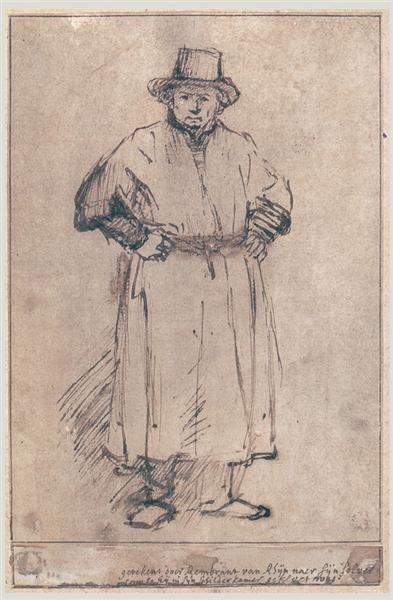Descrizione
Nel 1655, Rembrandt Harmenszoon Van Rijn, uno dei più grandi maestri Dal dipinto del diciassettesimo secolo, ha svolto un'opera che è sostenuta come una testimonianza intima e profonda della sua vita e della sua arte: il "auto -portrait con una tuta da studio". In questo auto -portrait, l'artista ci offre una visione sincera di se stesso, spogliando gli strati di frivolezza che spesso coprono le rappresentazioni dell'essere umano e la figura dell'artista in particolare. Attraverso la sua padronanza tecnica e il suo uso particolare del colore, Rembrandt cattura non solo il suo aspetto, ma anche qualcosa dello spirito che incoraggia il suo lavoro.
La composizione dell'opera è notevole in diversi aspetti. L'artista si presenta in tre quarti, con un gesto naturale e rilassato. Il suo aspetto diretto e penetrante stabilisce una connessione quasi immediata con lo spettatore, una caratteristica di molti dei suoi auto -portrai. Rembrandt sceglie di vestire una mano di studio di un tono scuro, che contrasta con lo sfondo più scuro di vernice. Questo uso cosciente dei costumi non solo rappresenta la vita quotidiana della sua vita come artista nel suo seminario, ma rafforza anche la tempo senza tempo del ritratto; Può essere trovato sia nel contesto del tuo tempo che del nostro. Inoltre, l'uso della luce nel lavoro è magistrale. La fonte luminosa, che sembra provenire dalla parte superiore sinistra, le accarezza il viso e le pieghe dei suoi vestiti, accentuando la consistenza del tessuto e rivelando le caratteristiche del viso. Questa tecnica di Chiaroscuro, che ha dominato Rembrandt, consente allo spettatore di provare una sensazione di volume e profondità, quasi come se l'artista fosse proprio di fronte a noi.
Il colore svolge un ruolo essenziale in questo lavoro. La tavolozza è prevalentemente oscura, con toni terribili e ricchi che evocano un'atmosfera di serietà, una sensazione che risuonava profondamente nel contesto della sua vita. Al momento, Rembrandt stava attraversando difficoltà finanziarie e personali e la malinconia può essere intravisto nel trattamento del proprio ritratto. La pelle, ha lavorato con toni caldi e sfumature sottili, evoca un'umanità grezza e autentica, priva delle idealizzazioni che spesso caratterizzavano i ritratti del loro tempo. Questo approccio più intimo e meno idealizzato al ritratto umano è stato uno dei contributi più significativi di Rembrandt all'arte del suo tempo.
In termini di stile, questo auto -portrait riflette il barocco, con la sua attenzione all'illuminazione drammatica, sui contrasti espressivi di luce e ombra e una narrazione visiva che cerca di coinvolgere emotivamente lo spettatore. Rembrandt è stato un pioniere nell'esplorazione della propria identità attraverso l'arte, e questo lavoro aggiunge una lunga serie di auto -portrai in cui sono messi sia il genio creativo che la vulnerabilità dell'individuo. È interessante notare che, per tutta la sua carriera, Rembrandt ha realizzato più di 90 portrai di auto, indicando non solo una ricerca di auto -esplorazione, ma una connessione continua con il cambiamento e la continuità della sua stessa esistenza.
"Auto -portrait con una tuta da studio" non è semplicemente un'immagine di un uomo nel suo seminario; È un documento della sua vita, del suo tempo e dell'universalità dell'essere umano. L'opera evoca un senso di rispetto per il lavoro dell'artista, un omaggio alla lotta, all'introspezione e alla ricerca di significato. Rembrandt, attraverso il suo pennello, invita lo spettatore a contemplare non solo la sua immagine, ma anche la costante sfida dell'arte come riflesso dell'esperienza umana.
KUADROS ©, una famosa vernice sul muro.
Dipinti ad olio fatti a mano, con la qualità degli artisti professionisti e il distintivo sigillo di KUADROS ©.
Servizio di riproduzione delle immagini con garanzia di soddisfazione. Se non sei completamente soddisfatto della replica del tuo dipinto, rimborsiamo i tuoi soldi al 100%.

